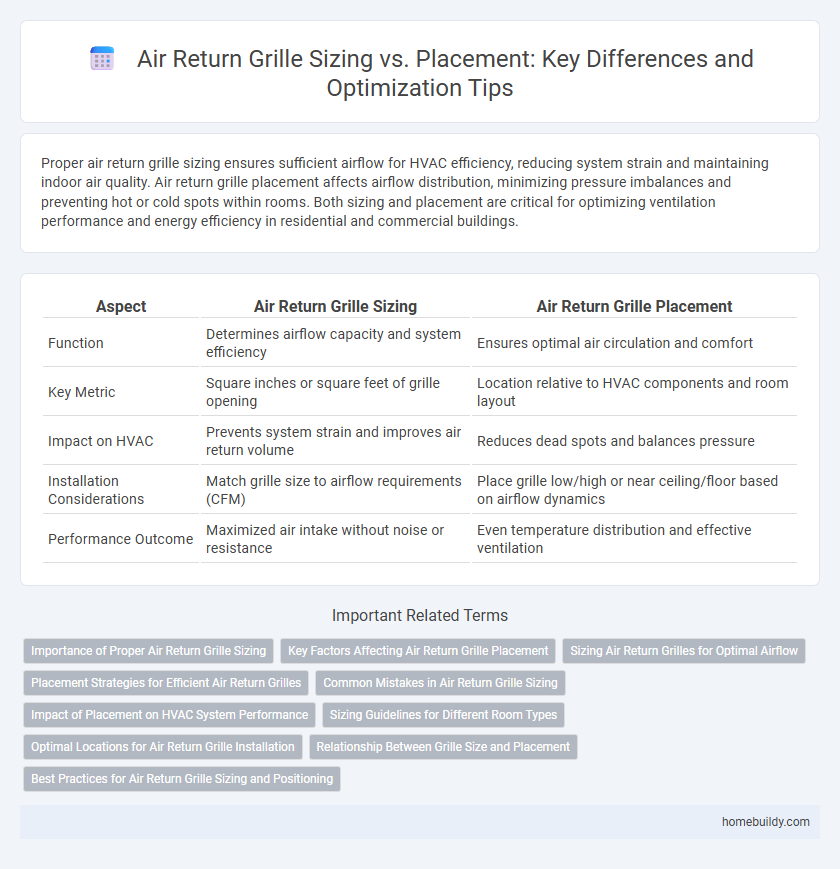Proper air return grille sizing ensures sufficient airflow for HVAC efficiency, reducing system strain and maintaining indoor air quality. Air return grille placement affects airflow distribution, minimizing pressure imbalances and preventing hot or cold spots within rooms. Both sizing and placement are critical for optimizing ventilation performance and energy efficiency in residential and commercial buildings.
Table of Comparison
| Aspect | Air Return Grille Sizing | Air Return Grille Placement |
|---|---|---|
| Function | Determines airflow capacity and system efficiency | Ensures optimal air circulation and comfort |
| Key Metric | Square inches or square feet of grille opening | Location relative to HVAC components and room layout |
| Impact on HVAC | Prevents system strain and improves air return volume | Reduces dead spots and balances pressure |
| Installation Considerations | Match grille size to airflow requirements (CFM) | Place grille low/high or near ceiling/floor based on airflow dynamics |
| Performance Outcome | Maximized air intake without noise or resistance | Even temperature distribution and effective ventilation |
Importance of Proper Air Return Grille Sizing
Proper air return grille sizing is crucial to maintain balanced airflow and ensure HVAC system efficiency by preventing pressure imbalances and reducing strain on the equipment. Undersized return grilles restrict airflow, causing increased energy consumption and uneven temperature distribution throughout the space. Accurate sizing based on airflow requirements supports effective air circulation, improves indoor air quality, and extends the lifespan of the HVAC components.
Key Factors Affecting Air Return Grille Placement
Air return grille placement is influenced by factors such as airflow patterns, room layout, and proximity to heat sources, which ensure efficient air circulation and system performance. Proper sizing complements placement by matching the return grille area to the HVAC system's airflow requirements, preventing pressure imbalances and noise. Careful consideration of ceiling height and furniture arrangement further optimizes return grille effectiveness and indoor air quality.
Sizing Air Return Grilles for Optimal Airflow
Proper sizing of air return grilles is critical to maintaining optimal airflow and system efficiency, preventing issues such as pressure drops and uneven air distribution. Oversized grilles can cause noise and energy waste, while undersized grilles restrict airflow, forcing HVAC systems to work harder and reducing overall performance. Accurate calculations based on airflow requirements (CFM), ceiling height, and duct dimensions ensure that air return grilles are sized correctly to balance comfort and energy efficiency.
Placement Strategies for Efficient Air Return Grilles
Proper air return grille placement directly influences HVAC system efficiency by optimizing airflow and reducing pressure drops. Positioning return grilles near ceiling heights in each room ensures effective circulation and prevents stagnant air zones. Strategic placement away from supply vents minimizes short-circuiting, enhancing overall indoor air distribution and comfort.
Common Mistakes in Air Return Grille Sizing
Common mistakes in air return grille sizing include selecting grilles too small for the airflow volume, which leads to increased system pressure and reduced HVAC efficiency. Incorrect sizing often results in noise issues and uneven air distribution, compromising indoor air quality and comfort. Proper sizing must consider the total return airflow and duct system design rather than just grille placement to ensure optimal performance.
Impact of Placement on HVAC System Performance
Proper air return grille placement significantly impacts HVAC system efficiency by ensuring balanced airflow and reducing pressure imbalances. Incorrect positioning can cause uneven air distribution, increased energy consumption, and reduced system lifespan despite optimal grille sizing. Optimizing grille placement enhances air circulation, improves indoor air quality, and maintains consistent temperature control throughout the space.
Sizing Guidelines for Different Room Types
Air return grille sizing varies significantly based on room type to ensure optimal airflow and HVAC efficiency; for bedrooms, a common guideline is to provide 1 square inch of grille area per square foot of floor space, while living rooms often require larger, up to 1.5 square inches per square foot, due to higher occupancy and air volume. Proper sizing accommodates the specific air volume needs and reduces noise and pressure drop, which are critical in sensitive spaces like offices or conference rooms where comfort and air quality are paramount. Accurate sizing prevents system strain and maintains balanced airflow, complementing strategic placement near return air pathways and minimizing dead zones for effective ventilation.
Optimal Locations for Air Return Grille Installation
Optimal locations for air return grille installation significantly impact HVAC efficiency and air circulation quality. Proper sizing ensures adequate airflow capacity while placement near the center of rooms or high-traffic areas enhances return air capture and system balance. Avoid positioning return grilles too close to supply vents or obstructed spaces to prevent short cycling and maintain consistent indoor air quality.
Relationship Between Grille Size and Placement
Air return grille sizing directly impacts airflow efficiency, with larger grilles enabling greater air volume to circulate and reducing system strain. Grille placement influences pressure dynamics and air distribution, where optimal positioning ensures balanced return airflow and minimizes noise issues. Coordinating grille size with strategic placement maximizes HVAC performance, maintains indoor air quality, and enhances system longevity.
Best Practices for Air Return Grille Sizing and Positioning
Proper air return grille sizing involves calculating the required airflow capacity to ensure efficient HVAC system performance and indoor air quality. Optimal placement should consider airflow patterns, avoiding obstructions and positioning grilles near ceiling or floor levels where air naturally circulates to maximize ventilation efficiency. Balancing grille size and strategic location reduces pressure drop, improves energy efficiency, and maintains consistent temperature distribution throughout the space.
Air return grille sizing vs Air return grille placement Infographic

 homebuildy.com
homebuildy.com